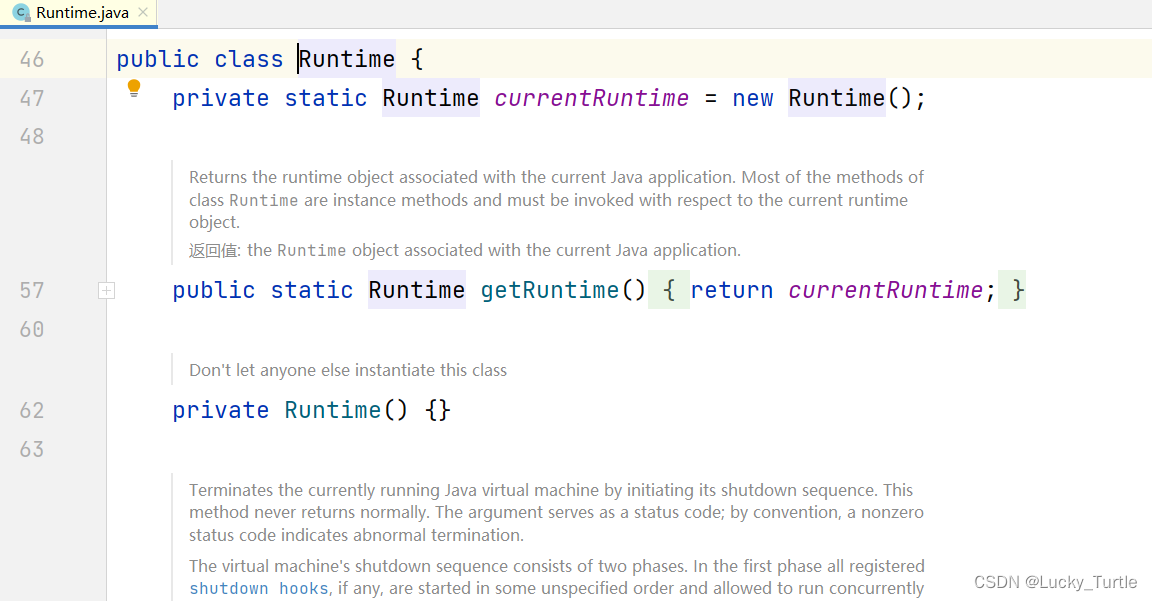【设计模式】三、概述分类+单例模式
文章目录
- 概述
- 设计模式类型
- 单例模式
- 饿汉式(静态常量)
- 饿汉式(静态代码块)
- 懒汉式(线程不安全)
- 懒汉式(线程安全,同步方法)
- 懒汉式(线程安全,同步代码块)
- 双重检查
- 静态内部类
- 枚举
- 单例模式在 JDK 应用的源码分析
- 总结
概述
设计模式类型
- 创建型模式:单例模式、抽象工厂模式、原型模式、建造者模式、工厂模式
- 结构型模式:适配器模式、桥接模式、装饰模式、组合模式、外观模式、享元模式、代理模式
- 行为型模式:模版方法模式、命令模式、访问者模式、迭代器模式、观察者模式、中介者模式、备忘录模式、解释器模式(Interpreter 模式)、状态模式、策略模式、职责链模式(责任链模式)
单例模式
采取一定的方法保证在整个的软件系统中,对某个类只能存在一个对象实例
该类只提供一个取得其对象实例的方法(静态方法)
比如 Hibernate 的 SessionFactory,它充当数据存储源的代理,并负责创建 Session 对象。SessionFactory 并不是轻量级的,一般情况下,一个项目通常只需要一个 SessionFactory 就够,这是就会使用到单例模式。
- 饿汉式(静态常量)
- 饿汉式(静态代码块)
- 懒汉式(线程不安全)
- 懒汉式(线程安全,同步方法)
- 懒汉式(线程安全,同步代码块)
- 双重检查
- 静态内部类
- 枚举
饿汉式(静态常量)
public class SingletonTest01 {public static void main(String[] args) {//测试Singleton instance = Singleton.getInstance();Singleton instance2 = Singleton.getInstance();System.out.println(instance == instance2); // trueSystem.out.println("instance.hashCode=" + instance.hashCode());System.out.println("instance2.hashCode=" + instance2.hashCode());}}//饿汉式(静态变量)class Singleton {//1. 构造器私有化, 外部能newprivate Singleton() {}//2.本类内部创建对象实例private final static Singleton instance = new Singleton();//3. 提供一个公有的静态方法,返回实例对象public static Singleton getInstance() {return instance;}}
优缺点:
- 优点:这种写法比较简单,就是在类装载的时候就完成实例化。避免了线程同步问题。
- 缺点:在类装载的时候就完成实例化,没有达到 Lazy Loading 的效果。如果从始至终从未使用过这个实例,则会造成内存的浪费
- 这种方式基于 classloder 机制避免了多线程的同步问题,不过,instance 在类装载时就实例化,在单例模式中大多数都是调用 getInstance 方法,但是导致类装载的原因有很多种,因此不能确定有其他的方式(或者其他的静态方法)导致类装载,这时候初始化 instance 就没有达到 lazy loading 的效果
- 结论:这种单例模式可用,可能造成内存浪费
饿汉式(静态代码块)
public class SingletonTest02 {public static void main(String[] args) {//测试Singleton instance = Singleton.getInstance();Singleton instance2 = Singleton.getInstance();System.out.println(instance == instance2); // trueSystem.out.println("instance.hashCode=" + instance.hashCode());System.out.println("instance2.hashCode=" + instance2.hashCode());}}//饿汉式(静态变量)class Singleton {//1. 构造器私有化, 外部能newprivate Singleton() {}//2.本类内部创建对象实例private static Singleton instance;static { // 在静态代码块中,创建单例对象instance = new Singleton();}//3. 提供一个公有的静态方法,返回实例对象public static Singleton getInstance() {return instance;}}
优缺点:
- 这种方式和上面的方式其实类似,只不过将类实例化的过程放在了静态代码块中,也是在类装载的时候,就执行静态代码块中的代码,初始化类的实例。优缺点和上面是一样的。
- 结论:这种单例模式可用,但是可能造成内存浪费
懒汉式(线程不安全)
public class SingletonTest03 {public static void main(String[] args) {System.out.println("懒汉式1 , 线程不安全~");Singleton instance = Singleton.getInstance();Singleton instance2 = Singleton.getInstance();System.out.println(instance == instance2); // trueSystem.out.println("instance.hashCode=" + instance.hashCode());System.out.println("instance2.hashCode=" + instance2.hashCode());}}class Singleton {private static Singleton instance;private Singleton() {}//提供一个静态的公有方法,当使用到该方法时,才去创建 instance//即懒汉式public static Singleton getInstance() {if(instance == null) {instance = new Singleton();}return instance;}
}
懒汉式(线程安全,同步方法)
public class SingletonTest04 {public static void main(String[] args) {System.out.println("懒汉式2 , 线程安全~");Singleton instance = Singleton.getInstance();Singleton instance2 = Singleton.getInstance();System.out.println(instance == instance2); // trueSystem.out.println("instance.hashCode=" + instance.hashCode());System.out.println("instance2.hashCode=" + instance2.hashCode());}}// 懒汉式(线程安全,同步方法)
class Singleton {private static Singleton instance;private Singleton() {}//提供一个静态的公有方法,加入同步处理的代码,解决线程安全问题//即懒汉式public static synchronized Singleton getInstance() {if(instance == null) {instance = new Singleton();}return instance;}
}
优缺点:
- 解决了线程安全问题
- 效率太低了,每个线程在想获得类的实例时候,执行 getInstance()方法都要进行同步。而其实这个方法只执行一次实例化代码就够了,后面的想获得该类实例,直接 return 就行了。方法进行同步效率太低
- 结论:在实际开发中,不推荐使用这种方式
懒汉式(线程安全,同步代码块)
优缺点:
- 不推荐使用
- 线程安全问题无法解决
双重检查
public class SingletonTest06 {public static void main(String[] args) {System.out.println("双重检查");Singleton instance = Singleton.getInstance();Singleton instance2 = Singleton.getInstance();System.out.println(instance == instance2); // trueSystem.out.println("instance.hashCode=" + instance.hashCode());System.out.println("instance2.hashCode=" + instance2.hashCode());}}// 懒汉式(线程安全,同步方法)
class Singleton {private static volatile Singleton instance;private Singleton() {}//提供一个静态的公有方法,加入双重检查代码,解决线程安全问题, 同时解决懒加载问题//同时保证了效率, 推荐使用public static synchronized Singleton getInstance() {if(instance == null) {synchronized (Singleton.class) {if(instance == null) {instance = new Singleton();}}}return instance;}
}
优缺点:
- Double-Check 概念是多线程开发中常使用到的,如代码中所示,我们进行了两次 if (singleton == null)检查,这样就可以保证线程安全了。
- 这样,实例化代码只用执行一次,后面再次访问时,判断 if (singleton == null),直接 return 实例化对象,也避免的反复进行方法同步.
- 线程安全;延迟加载;效率较高
- 结论:在实际开发中,推荐使用这种单例设计模式
静态内部类
public class SingletonTest07 {public static void main(String[] args) {System.out.println("使用静态内部类完成单例模式");Singleton instance = Singleton.getInstance();Singleton instance2 = Singleton.getInstance();System.out.println(instance == instance2); // trueSystem.out.println("instance.hashCode=" + instance.hashCode());System.out.println("instance2.hashCode=" + instance2.hashCode());}}// 静态内部类完成, 推荐使用
class Singleton {private static volatile Singleton instance;//构造器私有化private Singleton() {}//写一个静态内部类,该类中有一个静态属性 Singletonprivate static class SingletonInstance {private static final Singleton INSTANCE = new Singleton(); }//提供一个静态的公有方法,直接返回SingletonInstance.INSTANCEpublic static synchronized Singleton getInstance() {return SingletonInstance.INSTANCE;}
}
优缺点:
- 这种方式采用了类装载的机制来保证初始化实例时只有一个线程。 静态内部类方式在 Singleton 类被装载时并不会立即实例化,而是在需要实例化时,调用 getInstance 方法,才会装载 SingletonInstance 类,从而完成 Singleton 的实例化。
- 类的静态属性只会在第一次加载类的时候初始化,所以在这里,JVM 帮助我们保证了线程的安全性,在类进行初始化时,别的线程是无法进入的。
- 优点:避免了线程不安全,利用静态内部类特点实现延迟加载,效率高
- 结论:推荐使用.
枚举
public class SingletonTest08 {public static void main(String[] args) {Singleton instance = Singleton.INSTANCE;Singleton instance2 = Singleton.INSTANCE;System.out.println(instance == instance2);System.out.println(instance.hashCode());System.out.println(instance2.hashCode());instance.sayOK();}
}//使用枚举,可以实现单例, 推荐
enum Singleton {INSTANCE; //属性public void sayOK() {System.out.println("ok~");}
}
优缺点:
- 这借助 JDK1.5 中添加的枚举来实现单例模式。不仅能避免多线程同步问题,而且还能防止反序列化重新创建新的对象。
- 这种方式是 Effective Java 作者 Josh Bloch 提倡的方式
- 结论:推荐使用
单例模式在 JDK 应用的源码分析
java.lang.Runtime 就是经典的单例模式(饿汉式)

总结
- 单例模式保证了 系统内存中该类只存在一个对象,节省了系统资源,对于一些需要频繁创建销毁的对象,使用单例模式可以提高系统性能
- 当想实例化一个单例类的时候,必须要记住使用相应的获取对象的方法,而不是使用 new
- 单例模式使用的场景:需要频繁的进行创建和销毁的对象、创建对象时耗时过多或耗费资源过多(即:重量级对象),但又经常用到的对象、工具类对象、频繁访问数据库或文件的对象(比如数据源、session 工厂等)
